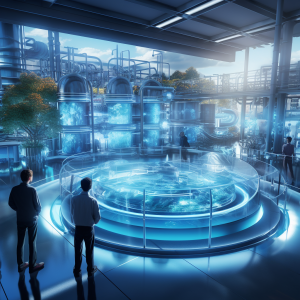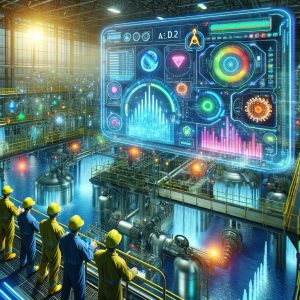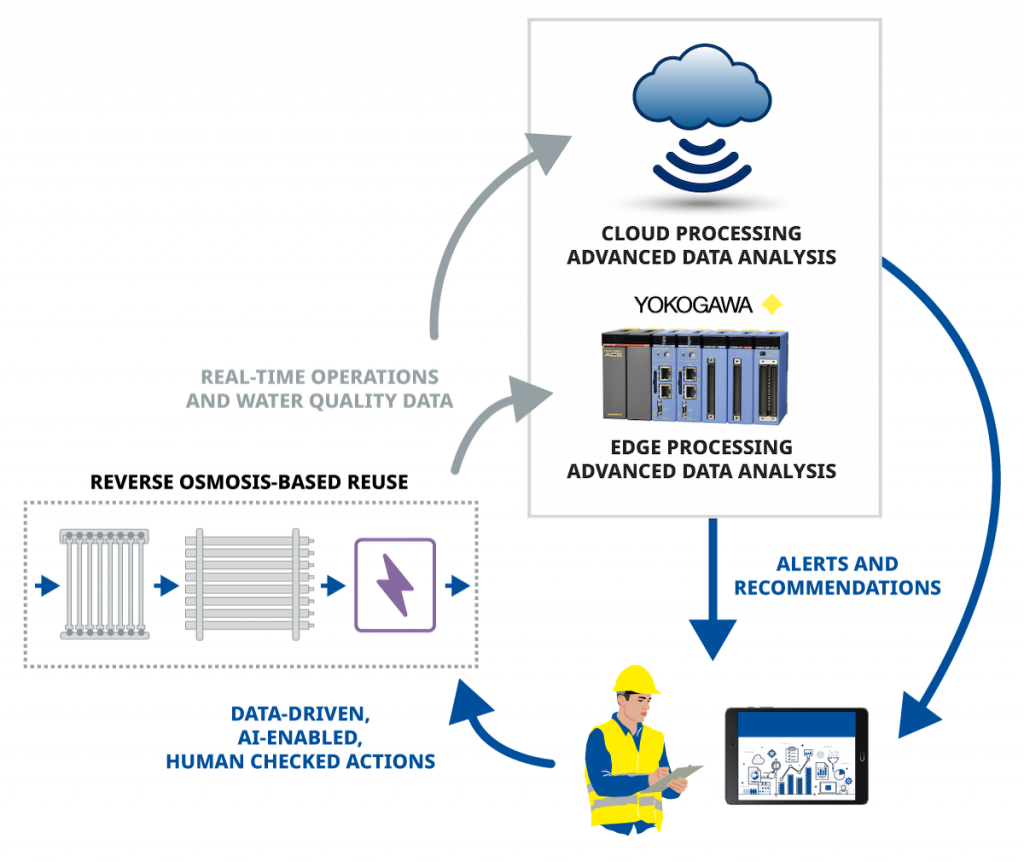AI Fault Detection
for Potable Reuse
Water Reuse In Depth
Issue #1 | January 2024
Lauren Core, Lawrence Berkeley National Laboratory
“The development and implementation of advanced controls for optimization, such as machine learning and artificial intelligence, is an area that is ripe for innovation.”
Andrew Salveson, Water Reuse Chief Technologist, Carollo Engineering
Artificial Intelligence (AI) grabs headlines for its ability to mimic, in its own distinctive way, human expression, from writing to artwork. However, its most important applications venture beyond generative AI to address challenges that have confronted humankind since the dawn of civilization. Secure and sustainable access to freshwater, for instance. Our most important natural resource has never been more severely threatened, and the global need for new sources of usable freshwater has never been as great.
As such, nations, regions, and communities around the world are actively pursuing alternative water supplies such as brackish water or potable reuse of municipal reclaimed water. However, purifying these sources means increases in energy, chemical use, and the need for talented, highly trained advanced water treatment operators.
It is therefore important to find ways to drive down the costs of energy and chemicals associated with water treatment, and to support operators.

In an effort to address such challenges, research supported by the United States Department of Energy’s National Alliance for Water Innovation (NAWI) is using AI and machine learning (ML) to reduce energy and chemical use, improve operational support, increase treatment system uptime, and improve confidence in purified water quality. The research aims to lower the cost of Reverse Osmosis (RO)-based advanced treatment (RBAT) by developing data-driven solutions to make treatment of municipal reclaimed water even more competitive with alternative new supplies.
“The researchers are part of the NAWI Alliance, which focuses on making desalination and water treatment technologies more efficient, effective, and reliable,” explains Peter Fiske, Executive Director of NAWI. “These technologies will enable 90% of our current non-traditional water sources to achieve pipe parity – when the levelized cost for treating and reusing nontraditional water sources are equal to the cost of today’s marginal water supplies.”
NAWI is the largest federal investment in water treatment, desalination, and water reuse research since the 1960s. The innovative national research program and public-private partnership brings together industry, academic, national laboratory, and other stakeholders across the country to advance next-generation desalination and water recycling technologies.
“The adoption of water reuse is gaining momentum. Studies like this that help improve the energy efficiency of water reuse keep that momentum strong, improving the health and resilience of communities across the United States,” said WateReuse Association Executive Director Patricia Sinicropi.
Reverse Osmosis to Reverse Water Insecurity
RO is a long-proven water treatment process that lies at the heart of most potable reuse systems. In the state of California, RO is a required treatment step for direct potable reuse projects, and is also used in most indirect potable reuse projects. RO-based facilities can render water from nontraditional sources safe for use in a wide range of applications, lessening our reliance on groundwater and other often overtaxed freshwater supplies.
But the effectiveness of RO comes at a cost. The RO-based advanced treatment (RBAT) approach, which typically also includes ultrafiltration and ultraviolet (UV) advanced oxidation, consumes a great deal of energy. This limits its scalability, especially for less affluent communities, and leads to questions about more environmentally sustainable alternatives or innovations.
Sampling Water…Without Samples

Researchers use AI to deliver more efficient testing and assessment of reclaimed water and to eliminate contaminants more adaptively and cost-effectively than traditional control methods allow. Take N-nitrosodimethylamine (NDMA) for example. NDMA once played a key role in the production of rocket fuel, but these days is mainly present in water as a disinfection byproduct. It is considered extraordinarily carcinogenic based on a study linking it to liver tumors in mice.
Because it is a very small molecule, NDMA can partially pass through RO. So, RBAT uses UV radiation to destroy NDMA, among other water quality benefits. This method destroys certain chemicals found in water through photolysis, which uses intense UV light to shatter the chemical bonds characteristic of targeted contaminants. UV also inactivates many pathogens, and in combination with certain chemicals like hydrogen peroxide, can further break down unwanted contaminants. Like RO, this process consumes a great deal of energy.
Traditionally, water treatment engineers have sampled reclaimed water from the multiple treatment processes that make up an RBAT array and sent them to be tested for NDMA and other contaminants. This testing process can take weeks or months. These samples contribute to a database reaching back months or years, and the updated series is analyzed to identify the highest concentration of NDMA across all samples. Since NDMA is an important contaminant and measuring it at a lab is slow and expensive, engineers and operators assume the worst. The intensity of UV light is set based on the highest or near-highest NDMA levels ever measured, and not changed.
The research team proposes to address the energy inefficiency typical of traditional RBAT-based treatment solutions by using an AI- and ML-based approach. It goes beyond direct sampling in favor of analyzing enormous datasets to train “soft sensors.” Soft sensors are AI models that use faster, cheaper data sources to predict the concentrations of slower, more challenging contaminants like NDMA. The result is a real-time estimate of key contaminants in a water source, including its most elusive. Researchers have demonstrated that AI can predict NDMA concentrations within ±3 parts per trillion of their actual value. This analysis informs the treatment process, reducing unnecessary UV treatments by roughly 50% while still reducing NDMA levels below regulatory limits. Further AI research in the same NAWI project have modeled microfiltration and RO with AI to detect faults or optimize energy and chemical use within those steps of RBAT systems.
“The development and implementation of advanced controls for optimization, such as machine learning and artificial intelligence, is an area that is ripe for innovation,” said Andrew Salveson, Project Lead and Water Reuse Chief Technologist, Disinfection Chief Technologist, and Project Manager at Carollo Engineering. “In some cases, advanced controls are built into individual processes, but the controls are not integrated across the entire system and don’t account for impacts on upstream or downstream processes. To the best of our knowledge, no studies have applied ML or AI to the operation of integrated RBAT trains in potable water reuse.”
Advanced Fault Detection for Better Reliability
This research organizes AI to support RBAT systems under two umbrellas: process control and fault detection. In 2023, researchers conducted a series of simulations against historical data collected from high-frequency online sensors used by water utilities partnering with the project. These simulations encompass five different fault-detection and process-control methods, the results of which were assessed at the end of the year. Performance targets included 10% energy savings, 20% cost savings, or 50% improved reliability.
The AI model predicting NDMA for UV energy savings was first demonstrated at Orange County Water District (OCWD) in 2023. In 2024, researchers will work to demonstrate fault detection methods at the OCWD facility in Fountain Valley, California. Water quality sensors connected to full-scale RO will send data to a cloud-based dashboard developed internally by OCWD. Advanced statistics will then screen out errors in this water quality data.
In 2024, researchers will also replicate the AI model demonstrated in 2023 at OCWD at another site: Las Virgenes Municipal Water District (LVMWD) in Calabasas, California. By strategically varying operational settings and collecting more NDMA data, researchers hope to create an even more accurate NDMA model.
These are still early days for AI in general, and especially for its use as a facilitator of water reuse and as treatment of nontraditional water sources. But this research has already demonstrated significant advantages in water-testing methods, and researchers expect similar results in their efforts to inform fault detection and process controls with AI. Full implementation of the research team’s findings for commercial and municipal purposes will only be possible after a thorough real-life trials mirroring large-scale water treatment and reuse. For now, AI holds immense promise for a new generation of more efficient, steadier water treatment facilities capable of safely delivering freshwater from a wider variety of nontraditional sources than current technology allows.
Research Partners: Baylor University: Amanda Hering; Carollo: Amos Branch, Andrew Salveson, Charlie He, Wen Zhao, Daniel Hutton, Kyle Thompson; Las Virgenes Municipal Water District: Burt Bril, Darrell Johnson, John Zhao, Steve Jackson; National Water Research Institute: Kevin Hardy; Orange County Water District: Han Gu, Jana Safarik, Megan Plumlee, Andrew Huang; United States Military Academy: Katheryn Newhart; West Basin Municipal Water District: Alejandra Cano-Alvarado, Margaret Moggia, Uzi Daniel, Veronica Govea; Yokogawa Corporation: Steve Hayden, Yasuhiro Matsui.
Author’s note: The views expressed in this column do not necessarily represent the views of the US Department of Energy or the US government.
This article is published by WateReuse Association in collaboration with National Alliance for Water Innovation (NAWI). Lauren Nicole Core is water specialist consultant with the World Bank Group and communications lead with Lawrence Berkeley National Laboratory, Berkeley, CA. NAWI is a public-private partnership that brings together a world-class team of industry and academic partners to examine the critical technical barriers and research needed to radically lower the cost and energy of desalination. NAWI is led by DOE’s Lawrence Berkeley National Laboratory in collaboration with National Energy Technology Laboratory, National Renewable Energy Laboratory, and Oak Ridge National Laboratory, and is funded by the Office of Energy Efficiency and Renewable Energy’s Industrial Efficiency and Decarbonization Office.
There are many more NAWI-supported research projects and innovators leading the charge for a circular economy through desalination and water supply research. NAWI provides several opportunities for participation, from applying for Alliance membership to volunteering to advise a project team as a Project Support Group member. Through relentless dedication to enhancing water accessibility, purity, and affordability, NAWI’s visionary research instills optimism for a future where access to clean water becomes a reality for all.


